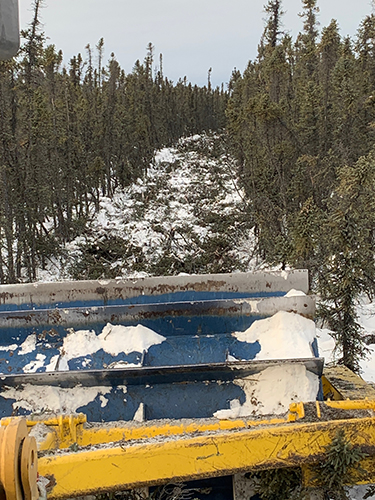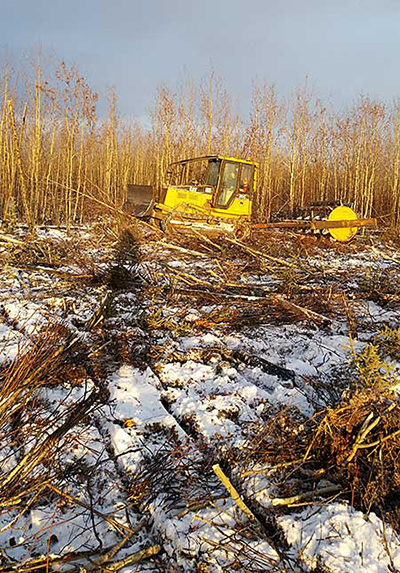Alaska Fish & Wildlife News
December 2019
Roller Chopping Enhances Habitat

Roller chopping looks bad at first glance, but in context it makes sense. It looks so bad in fact that a recent post to the ADF&G Facebook page regarding roller chopping was met with horror by one follower, who glanced at the picture without reading the post and commented that it should be illegal.
Roller chopping shears trees off at the base and crushes the stems. It looks like you drove a tank through the forest, dragging a steamroller. In context, it mimics natural processes. During spring break up, flooding rivers send rafts of ice plowing through riparian stands of aspen, alder and willow. All this vegetation has evolved to take this in stride, sprouting new growth from the root systems.
This winter is the third season that the Alaska Department of Fish and Game and Alaska Division of Forestry have teamed up to enhance wildlife habitat and reduce hazardous fuels on parts of the Delta Junction Bison Range southeast of Delta Junction. The project involves using heavy equipment to kill aspen trees in patches so that the root systems will regenerate aspen seedlings, which benefit grouse and moose by providing cover and forage. Another goal of the project is to create fuel breaks in stands of black spruce between the bison range and the Alaska Highway.
This season’s work focuses on roller chopping several aspen stands around the Gerstle Field Complex, as well as creating fuel breaks through black spruce between the Panoramic and Gerstle Fields to separate ‘fuel’ in the contiguous black spruce stands from the homes along the south side of the Alaska Highway. Additionally, we are roller chopping swaths through black spruce ‘islands’ in the Panoramic Field Complex to form smaller subunits that can be burned over several years to yield a mosaic of uneven-aged hardwood stands. In 2020, ADF&G is planning to burn several units of black spruce in the Panoramic Field. Once burned, these black spruce islands will provide much higher quality habitat for bison, moose, and grouse. This project is coordinated with State Forestry and the Bureau of Land Management to carry out the burn operations.

The roller chopping process uses a Caterpillar D7 to shear off the base of mature trees. Hitched behind the 12-ton Cat, a 12-foot wide drum with blades chops up the tree stems to aid in decomposition and allow animals to more easily move through the area. The roller chopper is filled with 1,763 gallons of glycol; the weight of the drum (about eight tons) combined with the blades is an effective tool to reduce trees into wood chunks. The frozen ground protects the roots systems, and the green stems break easily when they’re frozen. In the next growing season, new aspen shoots will regenerate on the site. Within two to three years, those stems will grow enough to provide winter forage for moose above the snow. Within a few years, the aspen will provide brood cover for ruffed and sharp-tailed grouse chicks. In a few more years, buds on the young trees will also serve as food for the grouse.
While the immediate vegetation response to roller chopping the mature aspen yields improved forage and cover for moose and grouse, this process also gives managers the option to convert these sites back to tilled fields. Planting oats and turnips attract bison away from the Delta Agricultural Project with the intent to keep them on the bison range during the harvest season and thereby limiting crop damage. The annual spring burns in the fields help regenerate grasses for bison to enjoy all summer.
Tim Mowry is a Public Information Officer with the Alaska Division of Forestry Wildland Fire & Aviation Program.
Subscribe to be notified about new issues
Receive a monthly notice about new issues and articles.
